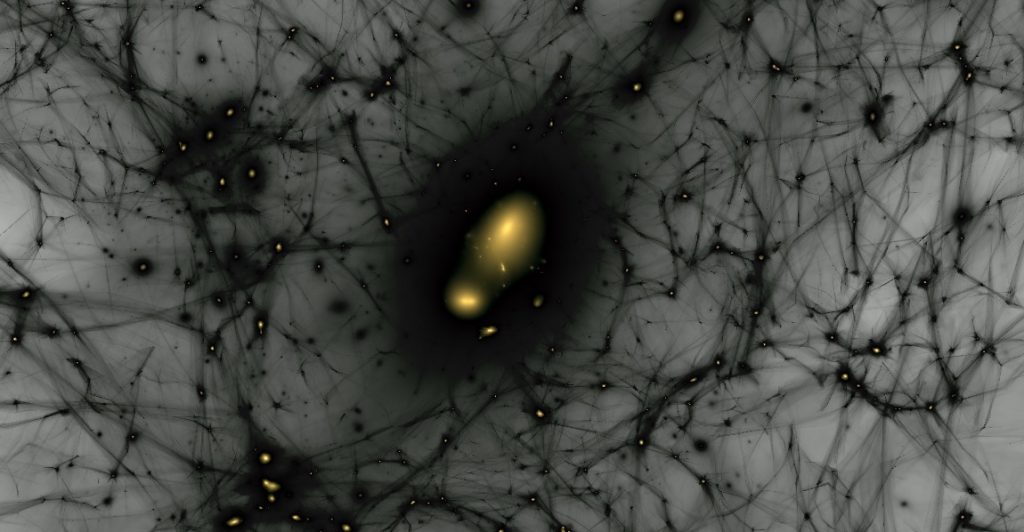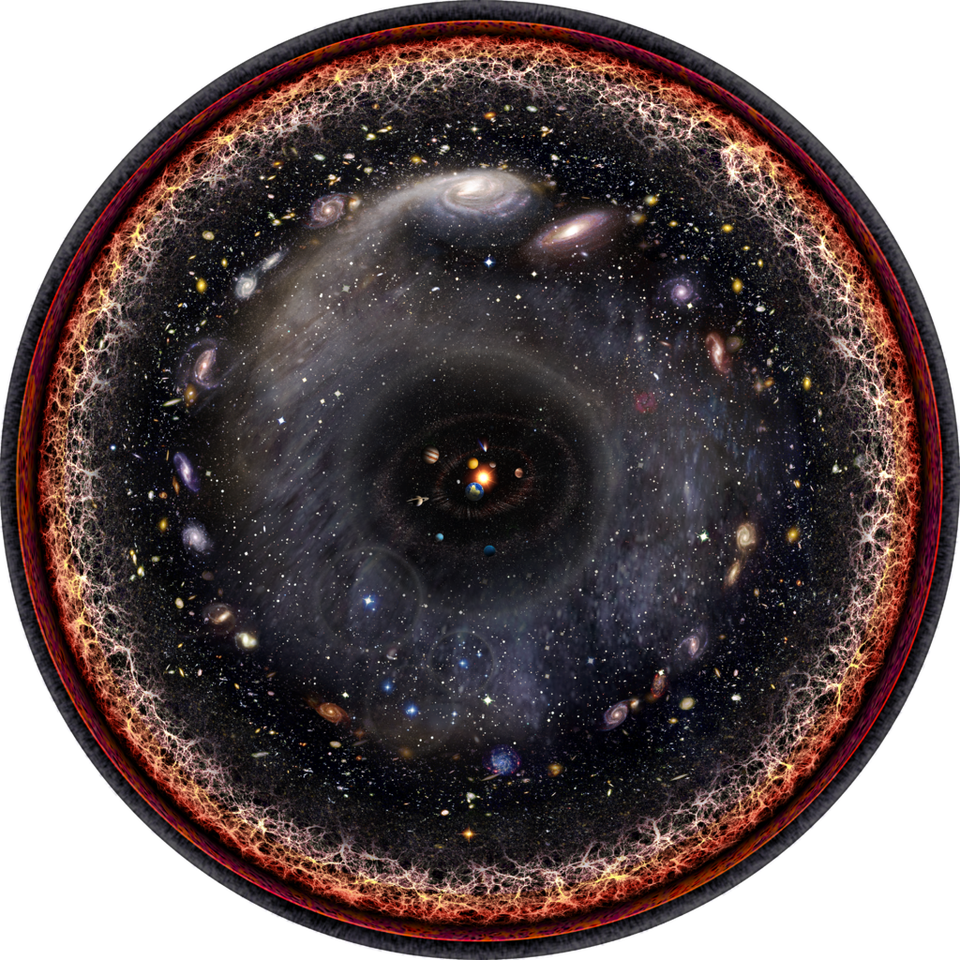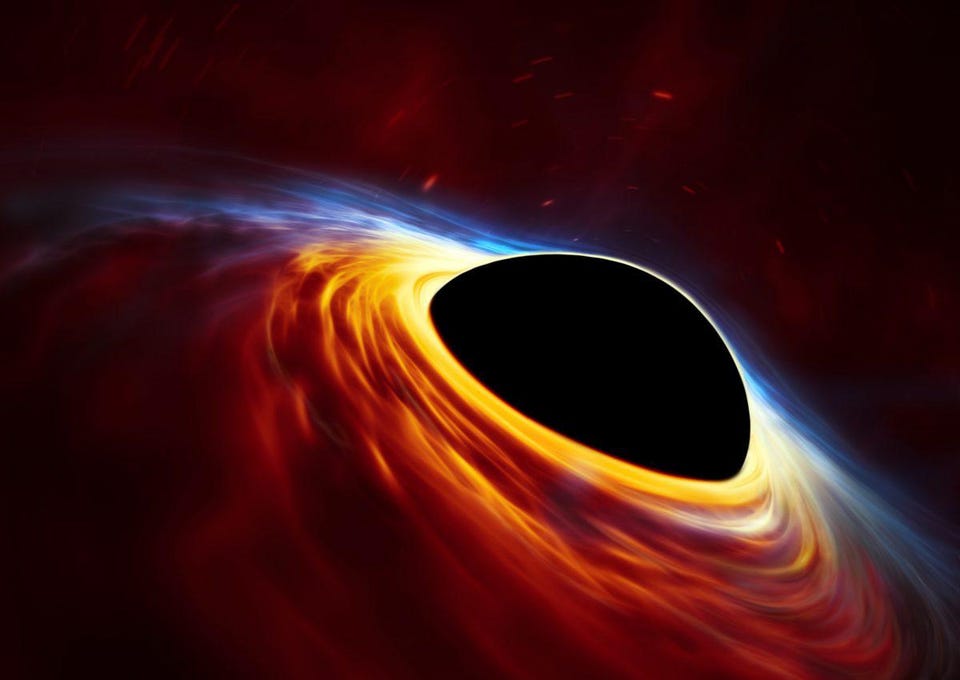Mystery solved: how the Universe makes galaxies without dark matter

- All throughout the Universe, dark matter provides ~85% of the mass of the largest cosmic structures, compared to only ~15% from normal matter.
- From individual galaxies to large groups and clusters to the web-like nature of the largest structure of all, almost everything we see is dominated by dark matter.
- Small galaxies, though, are different, as star formation typically expels some of the normal matter, creating dark matter-rich environments. So why do we have a few small galaxies that have no dark matter at all? At last, we know.
Here’s something to ponder that might leave you scratching your head in bewilderment: a few years ago, the first galaxies without dark matter were discovered, and this helps prove the existence of dark matter. This might be the most counterintuitive conclusion you could imagine, as dark matter’s defining characteristics are:
- it’s everywhere,
- it’s massive,
- it’s more abundant, by a 5-to-1 ratio, than normal matter,
- and it’s the primary driver of the formation of cosmic structures on all scales.
In every large-scale structure we see, including big spiral galaxies, giant ellipticals, groups of galaxies, rich clusters of galaxies, and even the grand cosmic web, dark matter dominates what’s out there, providing a phenomenal link between theory and observation.
And yet, there are galaxies out there — not many, and it’s only a few of the smallest ones — that have been found to possess practically no dark matter at all. This might sound like a “bug” in the theory of dark matter, but it’s actually a feature. There are only two plausible ways to create a galaxy without dark matter in a Universe that’s rife with it, and the first simulation to truly test the plausibility of both mechanisms has shown that one of them, in fact, actually reproduces what we see with extreme accuracy. It’s a triumph for the theory of dark matter; here’s the science of how it all works.

Step 1: Gravity
At the start of the hot Big Bang, the Universe was hot, dense, filled with matter and radiation, and almost — but not quite — perfectly uniform. This last property is vital, since if it were perfectly uniform everywhere, each and every region would experience exactly the same amount of gravitational attraction as every other region of space. But with even tiny imperfections, you’ll have overdense regions that preferentially attract more matter into them than others, as well as underdense regions that give their matter up to the denser surrounding regions.
Our Universe, as best as we can tell, was born with 99.997% perfect uniformity, with underdense and overdense regions that deviated by only ~0.003% from the average: about 1-part-in-30,000. Still, that’s plenty, and after a few hundred million years, stars and galaxies began to form, growing from these initial seeds of structure. Matter, both normal and dark, gets attracted to the densest nearby regions, creating a filamentary structure of mass known as the cosmic web, separated by enormous voids. Galaxies form along the filaments, while the places where the filaments intersect give rise to larger structures like galaxy groups, clusters, and even superclusters.

Step 2: Stars form
In the early stages of structure formation, gravity treats normal matter and dark matter the same: they both have mass, and hence they both experience the same forces. But once you start creating large collections of mass, you wind up with gravitationally bound structures, and that changes everything.
When dark matter particles become bound, they simply orbit gravitationally, with no other interactions. There’s no interaction with photons; there are no collisions between dark matter particles and normal matter particles; there are no dark matter-dark matter interactions expected to take place; there are no nuclear reactions that dark matter undergoes. As far as we can tell, the distinguishing feature of dark matter is that it’s invisible in absolutely every way, except for the fact that it has mass and experiences gravitation. That’s it.
Normal matter, on the other hand, is made of the “stuff” we’re familiar with: electrons and atomic nuclei, for the most part. When normal matter becomes bound, it experiences all sorts of interactions in addition to just gravitation. Radiation can exert pressure on normal matter; normal matter can collide with other normal matter particles and stick together; and at high enough temperatures and densities, even nuclear reactions can occur. While the dark matter remains in a puffy, diffuse, spheroidal halo surrounding each and every galaxy, the normal matter eventually sinks towards the core, and will begin forming stars once enough mass gets gathered in one place.

Step 3: Now we’re cooking
Up until this point, even though the normal matter had gathered in the centers of these early structures while the dark matter remained diffuse, pretty much every structure — on both small scales and large ones — had that same universal ratio of dark matter to normal matter: 5-to-1, the same ratio as the overall cosmic abundance.
But once stars form, everything changes.
The reason, plain and simple, is radiation. In their cores, nuclear reactions convert a small but substantial percentage of the star’s mass into energy, and that energy radiates away. The normal matter can absorb this radiation, causing it to heat up, but the dark matter cannot. The most massive stars perform double duty:
- they emit the greatest amount of the highest-energy radiation, which can create winds that are strong enough to accelerate the normal matter to tremendous speeds,
- and they also have the shortest life cycles, with many of them culminating in tremendously energetic events, such as core-collapse supernovae.
This radiation affects the normal matter, pushing much of it away from the center, but has no effect on the dark matter. Only the changing gravitational configuration of the normal matter impacts the dark matter: a secondary and sub-dominant effect.

If your star-forming galaxy is large and massive, this doesn’t change very much. Sure, the normal matter will get pushed out of the center, but the combination of gas in the outer halo and the large overall mass of the galaxy will prevent that matter from escaping, due to friction and gravitation together.
However, if you form enough stars — particularly enough massive stars — and your galaxy is low enough in mass, a major episode of star-formation can fully expel the normal matter that would normally be present in the forms of gas, dust, and plasmas. All you’d have left, after the fireworks cleared, would be the stars you formed during that initial wave embedded in a dark matter halo. The rest of the normal matter would have been returned to the intergalactic medium: the space between the galaxies.
What you’d expect, typically, is that you’d see that same 5-to-1 ratio of dark matter to normal matter in all large-scale cosmic structures, but then once you got down to a critical size or mass, you’d expect the dark matter to normal matter ratio to increase, with the lowest-mass galaxies having the most severely lopsided ratios. In the most extreme cases, we can get dark matter to normal matter ratios of hundreds or even thousands to one.

Step 4: the unusual examples
Of course, that’s only what happens on average. In a Universe this large, with trillions of galaxies and sextillions of stars, you’re going to have some outliers, and that’s often where the most interesting scientific lessons are hiding. The big ingredient we need to add in is this: galaxies interact, and gravitation will draw galaxies in, on large scales, to form galaxy groups and galaxy clusters.
One of the remarkable things we’ve observed over the past two decades, primarily through the combination of X-ray emission (which traces the gas that gets heated due to mergers) and mapping via gravitational lensing (which traces out the overall mass, irrespective of what type of matter it’s made out of), is the fact that gravitational interactions can separate normal matter from dark matter.
Interacting galaxies have also been seen to form stellar streams, where tidal forces can rip clouds of gas out of galaxies entirely, causing them to contract and experience a massive wave of star formation. With no dark matter in these objects, that wave of star formation can efficiently expel the remaining normal matter, leaving only stars — and no normal or dark matter — in these gravitationally bound structures.

It’s also possible to separate normal matter and dark matter via a different mechanism: by having a small, dark matter-rich galaxy experience a gravitational encounter with a larger, more massive galaxy. In this scenario, the larger galaxy will tear the smaller one apart, but will do so from the outside-in. Because the dark matter is distributed in a diffuse, fluffy, cloud-like structure, while the normal matter is concentrated in the galaxy’s center, the dark matter gets stripped away first, leaving only the normal matter behind.
The primary difference between these two scenarios is how long these objects will survive. In the first example, these structures with only stars in them can persist until they have a strong enough interaction with another galaxy, which means they might remain, once created, for hundreds of millions or even billions of years. In the second example, however, these smaller galaxies are in the process of being torn apart, and what we might be witnessing as a “galaxy without dark matter” is temporary. It’s only because we happen to be looking at a critical snapshot in time that we can catch these galaxies as they’re transitioning from being dark matter-dominated to being torn apart completely.

Observations
Over on the observational side, we’ve found a handful of these galaxies. The first two, NGC 1052-DF2 and NGC 1052-DF4, two ultra-diffuse satellite galaxies of the large, relatively nearby galaxy NGC 1052, were found first: with the Dragonfly Telephoto Array. More recently, six new galaxies have been found that also appear to be lacking dark matter, also nearby, and also as small satellite galaxies that are found nearby much larger neighbors.
The big question, of course, is why?
Given that we can only observe these galaxies as they are right now — a single snapshot in cosmic time — there’s only so much the observations can tell us on their own. To know why we have galaxies that appear to be lacking dark matter requires the application of a different technique: to try and simulate the Universe, from large cosmic scales down to small ones that capture the behavior of both normal and dark matter in these different “interaction” scenarios, and to see which of them, if any, match the observations that we have. In a tour-de-force paper published in Nature Astronomy on February 14, 2022, a team of researchers led by Jorge Moreno accomplished exactly that.

The key result
It took a state-of-the-art cosmological simulation that included dark matter, gas, star-formation, the feedback of radiation, the energy injection of supernovae, and incredibly high mass resolution to find the solution. The researchers needed to be particularly careful — arguably, more meticulous than any research team performing cosmological simulations have ever been — in identifying even slight overdensities on small scales to identify where galaxies form in their simulations.
What they found, remarkably, is that there was a set of conditions that not only gave rise to galaxies lacking dark matter, but that those galaxies had properties consistent with the dark matter-free galaxies we’ve actually observed in our real Universe. They had similar:
- stellar masses,
- physical sizes,
- physical shapes (what astronomers call morphology),
- and speeds for the internal motions of their stars (what astronomers call velocity dispersion).
The key factor is having extremely close encounters between two different galaxies, at least one of which is large and massive: comparable at least to the mass of the Milky Way.
In galaxy groups and clusters that had at least one massive galaxy in their centers, they found that a substantial fraction of those groups, right around a third of them, possessed at least one satellite galaxy, comparable in mass to one of our Magellanic Clouds, that was either free of dark matter or substantially deficient in the amount of dark matter it possessed.

The next steps, of course, will be brought to us by the bourgeoning suite of next-generation telescopes that are optimized for finding and measuring the properties of satellite galaxies around large galaxies in the relatively nearby Universe. Whereas most dark matter-dominated galaxies will have dark matter to normal matter ratios of 5-to-1 or greater, this new study has not only revealed a mechanism for producing low-mass galaxies that are dominated by normal matter instead of dark matter, but has made predictions for their expected abundances, properties, and distances from their host galaxies. Only time, and future observations, will bear out whether those predictions are abundantly correct or not.
However, one thing is clear: if you want to have a Universe that has galaxies of the same scale that come in two varieties:
- dark matter-dominated,
- and dark matter-deficient or even dark matter-free,
you cannot do that without some form of dark matter. Having both types of galaxies is only possible if dark matter exists, and a physical mechanism exists for separating normal matter from dark matter. For the first time, not only do we have a demonstration of precisely that, but the dark matter-deficient and dark matter-free galaxies predicted to exist from a simulation are actually consistent with the galaxies we observe in real life.





